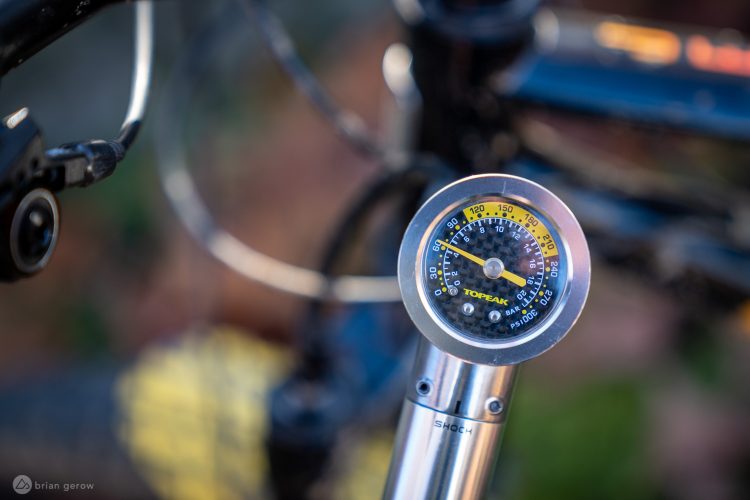
In mountain bike tire reviews we often point out whether a tire can be mounted with a floor pump or if the bead begs for a stronger gust of wind. This TLR Flash Charger Floor Pump from Bontrager has managed to seat nearly every bead since we started testing it at the beginning of the year, blasting stacks of test tires into place on a wide variety of different rims, inserts, and tubeless setups.
While a cacophonic air-compressor maintains the benefit of not breaking a sweat across your brow, I’ll wager that that if a tire can’t be mounted with the TLR Flash Charger it’s not likely to stay mounted out on the trail. This little set of cylinders is powerful. Of the two tires I couldn’t mount with this pump, one was far too loose to be mounted by my neighbor’s massive compressor, and the other was far too tight, requiring the trusty “tube-it-first” method before the bead would settle in.

Prior to receiving this test pump, I had used my roommate’s Bontrager TLR Flash Charger for several years, and the sturdy little blower does seem to have one consumable component. After being pressed onto and ripped from hundreds of threaded valve stems the head eventually has to be replaced. Once those valve threads have removed enough of the internal plastic the pump can no longer create an air-tight seal on Presta or Shrader valves, leaking slightly as you pump. The head of my roommate’s pump has been swapped several times since. At $129.99 (available online from Trek) for a pump that will last half of a decade or more that little replacement part seems reasonable. While we were not able to find a Bontrager replacement head, there are plenty of similar chucks that fit the same hose, or you can replace the whole hose and head for $14.99.

Like other tubeless floor pumps, the Bontrager TLR Flash Charger has a cylindrical gas tank that fills while you pump. Then, just flip the valve open to release the air into the tire and pop it into place — just like an air compressor but without the electrical assistance. With a little soapy water on the bead, most mountain bike tires snap into position from a charge of 100-110 PSI, while cyclocrosss and road tires will seat better with higher pressure in the charger to blow their lighter beads into place. Some road and gravel rubber can take a full 160 PSI to pop across the rim bed. At these pressures, it takes around a minute to pump enough pressure for MTB tires and ninety seconds for a road tire. Most home-size air compressors take a similar amount of time to pressurize, though they don’t provide the upper body workout and their electric motors make an insufferable noise.
This pump comes along for the ride any time we drive to a trailhead, just in case a tire tears and needs to be replaced. It saved more than one ride this past season when the thin trail casings on test bikes didn’t hold up. It weighs about 2.8 kilos and takes up roughly the same space as any other floor pump. If you have space for an extra tire, the pump is worth packing.
Working alongside an accurate digital tire gauge, this Bontrager TLR Flash Charger also sees regular use as a daily tire pressurizer. When you plug the head onto a valve stem and flip the pump’s valve open the air between the tire and the tank has to equalize. The result is that your tire will gain or lose some amount of air, depending on how much air is in the pump tank. The shifting pressure can be frustrating if you’re trying to reach a precise PSI measurement with the pump alone. You can get there, but it takes some patience.
Another method to reach precise pressure is to over-inflate the tire slightly and then release pressure by depressing the valve-core and checking with a hand-held digital gauge until it’s just right. It’s a little like tuning a guitar string sharp and slowly dropping the note into place. I typically leave 25-26 PSI in the tank so that when it’s time to ride all I have to do is mount the pump head, flip the valve, pump a few breaths, and then dial down the pressure before rolling out of the garage.

Finally, I don’t recommend using the bleed valve to tune tire pressure in tubeless tires. While you can hit a fairly precise number by over-inflating and bleeding the excess pressure with the pump attached, this will inevitably introduce some sealant into the pump. Over time, that sealant could eventually cause problems with the pump’s internals, and it certainly won’t extend its life. I tested this concern by bleeding air from a freshly mounted tire and then removing the hose to take a closer look inside. Sure enough, there was latex fluid in the tube, and likely further inside. This can all be prevented by using a hand-held pressure gauge and a finger to bleed air instead of the pump.
Bontrager also offers this pump with a digital display for folks who prefer batteries.
⭐️ Find the Bontrager TLR Flash Charger pump at Trekbikes.com.






















0 Comments